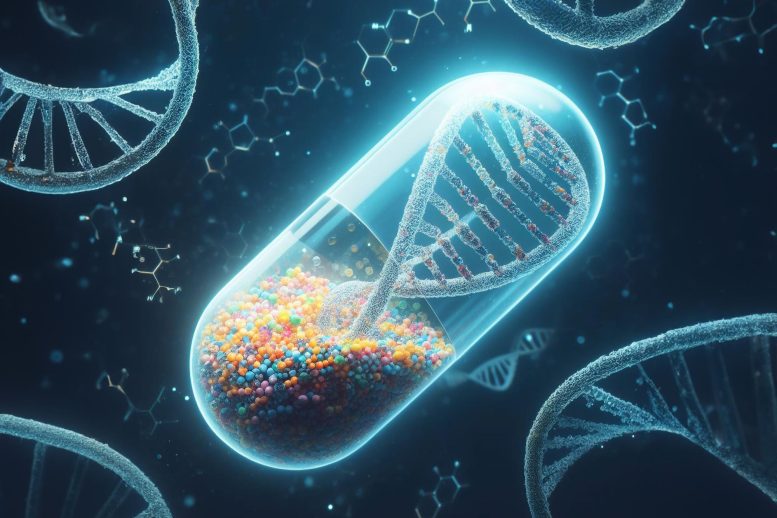
Creating artificial life is a recurring theme in both science and popular literature, where it conjures images of creeping slime creatures with malevolent intentions or super-cute designer pets. At the same time, the question arises: What role should artificial life play in our environment here on Earth, where all life forms are created by nature and have their own place and purpose?
Associate professor Chenguang Lou from the Department of Physics, Chemistry, and Pharmacy, University of Southern Denmark, together with Professor Hanbin Mao from Kent State University, is the parent of a special artificial hybrid molecule that could lead to the creation of artificial life forms.
They have now published a review in the journal Cell Reports Physical Science on the state of research in the field behind their creation. The field is called “hybrid peptide-DNA nanostructures,” and it is an emerging field, less than ten years old.
Potential Applications of Artificial Life
Lou’s vision is to create viral vaccines (modified and weakened versions of a virus) and artificial life forms that can be used for diagnosing and treating diseases.
“In nature, most organisms have natural enemies, but some do not. For example, some disease-causing viruses have no natural enemy. It would be a logical step to create an artificial life form that could become an enemy to them,” he says.
Similarly, he envisions such artificial life forms can act as vaccines against viral infection and can be used as nanorobots or nanomachines loaded with medication or diagnostic elements and sent into a patient’s body.
“An artificial viral vaccine may be about 10 years away. An artificial cell, on the other hand, is on the horizon because it consists of many elements that need to be controlled before we can start building with them. But with the knowledge we have, there is, in principle, no hindrance to producing artificial cellular organisms in the future,” he says.
Molecular Building Blocks
What are the building blocks that Lou and his colleagues in this field will use to create viral vaccines and artificial life? DNA and peptides are some of the most important biomolecules in nature, making DNA technology and peptide technology the two most powerful molecular tools in the nanotechnological toolkit today.
DNA technology provides precise control over programming, from the atomic level to the macro level, but it can only provide limited chemical functions since it only has four bases: A, C, G, and T.
Peptide technology, on the other hand, can provide sufficient chemical functions on a large scale, as there are 20 amino acids to work with. Nature uses both DNA and peptides to build various protein factories found in cells, allowing them to evolve into organisms.
Recently, Hanbin Mao and Chenguang Lou have succeeded in linking designed three-stranded DNA structures with three-stranded peptide structures, thus creating an artificial hybrid molecule that combines the strengths of both. This work was published in Nature Communications in 2022.
Global Advancements in Hybrid Structures
Elsewhere in the world, other researchers are also working on connecting DNA and peptides because this connection forms a strong foundation for the development of more advanced biological entities and life forms.
At Oxford University, researchers have succeeded in building a nanomachine made of DNA and peptides that can drill through a cell membrane, creating an artificial membrane channel through which small molecules can pass. (Spruijt et al., Nat. Nanotechnol. 2018, 13, 739-745)
At Arizona State University, Nicholas Stephanopoulos and colleagues have enabled DNA and peptides to self-assemble into 2D and 3D structures. (Buchberger et al., J. Am. Chem. Soc. 2020, 142, 1406-1416)
At Northwest University, researchers have shown that microfibers can form in conjunction with DNA and peptides self-assembling. DNA and peptides operate at the nano level, so when considering the size differences, microfibers are huge. (Freeman et al., Science, 2018, 362, 808-813)
At Ben-Gurion University of the Negev, scientists have used hybrid molecules to create an onion-like spherical structure containing cancer medication, which holds promise to be used in the body to target cancerous tumors. (Chotera et al., Chem. Eur. J., 2018, 24, 10128-10135)
“In my view, the overall value of all these efforts is that they can be used to improve society’s ability to diagnose and treat sick people. Looking forward, I will not be surprised that one day we can arbitrarily create hybrid nanomachines, viral vaccines, and even artificial life forms from these building blocks to help society combat those difficult-to-cure diseases. It would be a revolution in healthcare,” says Chenguang Lou.
Reference: “Peptide-DNA conjugates as building blocks for de novo design of hybrid nanostructures” by Mathias Bogetoft Danielsen, Hanbin Mao and Chenguang Lou, 5 October 2023, Cell Reports Physical Science.
DOI: 10.1016/j.xcrp.2023.101620